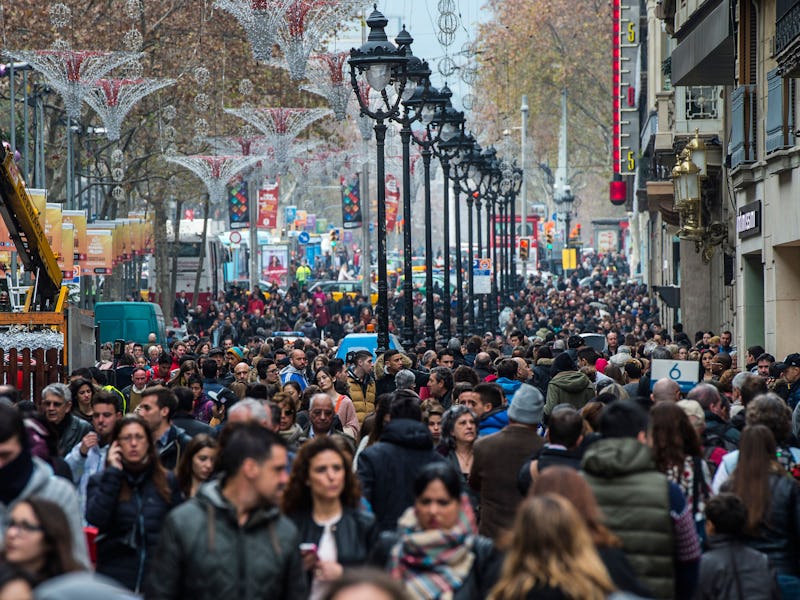As Urban Populations Explode, Personal Space Will Become a Rare Luxury
Avoiding eye contact and turning our backs to strangers can go only so far, as our neighbors increasingly wall us in.

On a crowded subway car, finding a pair of empty seats is like spotting a crisp 20 on the floor: It’s rare; it’s fortuitous; and it makes us savagely possessive. In the era of overpopulation, personal space is a coveted luxury. (There is no shade like the shade thrown at a sprawling train seatmate.) We’re poised to add another four billion bodies to the planet before this century is over, and we’re not making any more room. If we can’t change how much physical space we have, we’ll have to change how much psychological space we need.
For better or for worse, it’s up to us to negotiate with our environments for comfort. “[Personal space] is not some immutable property of a person,” says Indiana University’s Dan Kennedy, Ph.D., a neuroscientist studying social behavior. “[It] is something we construct dynamically.”
Kennedy means there’s no hardwired requirement to maintain, for example, a two-stall radius from everyone in the bathroom, at least not psychologically. Nobody welcomes the sudden appearance of pants and ankles in the stall next door, if the rest of the bathroom is empty, but if all toilets are taken, it suddenly seems a lot less intrusive. Adapting our concept of personal space for the short term is a fact of life, says Kennedy. Long-term adaptation, however, comes at a price.
“What happens if, over time, you force someone who wants a large space to exist in a smaller space?” Kennedy asks. “Either they adapt or they maintain this constant state of arousal or discomfort than they’d rather not be in.”
Living in a densely populated city is an exercise in mitigating discomfort. Navigating the average Manila market is like battling for space in a New York City dive bar; out in public, the feeling of strange skin on skin is inevitable. We’ve developed strategies, like avoiding eye contact or turning our back to people in a crowd, to combat less tangible intrusions. Intermittent escapes to private homes or offices are crucial to maintaining sanity.
But in the long term, city living is public living. “When you’re on a subway or a train, there are times that it’s very uncomfortable,” Kennedy says. “What does this increase in discomfort and arousal in the long term do?”
Though the global population has flocked to urban centers since the Industrial Revolution, it’s only relatively recently that researchers have looked into the long-term effects of living in densely populated areas. The results all highlight one major trend: City living is psychologically hazardous. “The environments are very different, and they’re different from what we evolved to live in,” Kennedy says. “And it’s going to have effects on our mental health.”
He points to a 2005 review study, published in Schizophrenia Bulletin, that suggests a causative link between urban environments and psychosis. A 2011 paper published in Nature showed that the brains of people who grow up in cities are disproportionally active in response to stress. Overcrowding, of course, is just one of many reasons living in a modern city is so psychologically taxing — there’s also more crime, more noise, more pressure at work — but it’s among the most visceral.
In the cities of the near future, bathroom stalls will be full, all the time. In 2014, the World Health Organization estimated that 54 percent of the global population lived in cities, up from 34 percent in 1960, and future growth is likely to take place in underdeveloped regions where major urban environments are just beginning to take root.
A video of the world’s population growth on the aptly named WorldPopulationHistory.org presents an alarming visual explosion of the exponential growth that grew out of the Industrial Revolution. In 1750, roughly a decade before it began, the global population hovered around 717 million people — and you can see only few sparse urban areas on the world map, largely clustered in India and China. By 1850, Europe is suddenly awash in urban sprawl, with the world’s population having exploded to 1.22 billion after rural folk migrated to cities to work in factories. Dodging neighbors in crowded alleys was very different from traversing open fields, but city dwellers learned to make due (psychologically, at least; physically, they were too busy battling the rampant spread of infectious disease). Then, as now, they didn’t have much of a choice.
Concepts of personal space, Kennedy reminds us, are constructions varying with culture, time, and situation. If the United Nations’ estimate is correct, we’ll be dealing with 11.2 billion people in 2100 — more than 4 billion of whom, the World Bank predicts, will be in Africa. That world will be very different from the one we’re used to, and so too will the next generation’s concept of personal space. The chronic stress induced by city living — the kind being blamed for declining mental health — can exist only if the environment is perceived as stressful. Will the next generation of kids growing up in Mumbai, Lagos, and Colombo be better than we are at sharing personal space? Probably. Rather than speculate on our ability to adjust — Kennedy already knows we’re good at it — he chooses to put his faith in future city planners.
“Even in a crowded city, I don’t think we’ll be packed in there like sardines, in these constant anxiety-provoking situations that there’s no escape from,” he says.
“But in those cases, what is the reaction going to be? I’m not sure.”